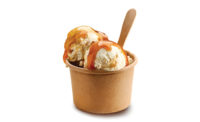Ice cream’s recent comeback — which began in earnest last year — shows no signs of waning. Retail sales of ice cream in the United States rose a respectable 3.9% to $6.1 billion during the 52 weeks ending Aug. 6, 2017, according to data from Chicago-based Information Resources Inc. (IRI). Unit sales climbed 2.6% to 1.6 billion.
Milk | Cheese | Cultured | Ice Cream | Butter | Non-dairy Beverages | Ingredients | Exports
Unlike some other food segments associated with indulgence, the ice cream subcategory doesn’t appear to be suffering from consumers’ collective health quest. In fact, only 11% of surveyed U.S. consumers reported cutting back on ice cream or frozen treat consumption due to health concerns, stated global market research firm Mintel in its 2017 “Ice Cream — Global Annual Review.” And an almost equal share — 10% — said they were actively avoiding “healthy versions” because they are “meant to be treats.”
Perhaps that’s why some subcategories perceived as more healthful by consumers have been struggling. For example, the frozen yogurt/tofu segment saw a 7.7% decline in dollar sales and a 10.9% drop in unit sales during the same timeframe, the IRI data show.
Clean labels are in
Ice cream consumers might want to indulge, but that doesn’t mean they are ignoring what’s on the ingredient labels. There’s a strong push on consumers’ part for cleaner labels, noted Luconda Dager, president of Utica, Ohio-based Velvet Ice Cream Co.
“We’ve worked closely with our ingredient suppliers and have carefully selected ingredients with less or no processing,” she said. “Incorporating these simpler ingredients has made it possible for us to offer cleaner, easy-to-understand labels to our customers.”
The Velvet Ice Cream All Natural line of ice cream meshes well with the clean-label trend. The company recently added two new flavors to the line, Dager said — black cherry vanilla and toasted coconut fudge.
For its part, Prairie Farms, Edwardsville, Ill., converted its traditional Prairie Farms brand ice cream to clean label this year. The conversion included the addition of several “new and unique flavors,” said Dave Znika, division manager for ice specialties.
Consumers also are clamoring for clean labels that go beyond natural, said Samantha Hill, director of growth for Snohomish, Wash.-headquartered Snoqualmie Ice Cream. They want options that are GMO-free, organic and more.
To meet demand here, Snoqualmie introduced a line of super-premium organic craft ice cream early in 2017. The French-style frozen custard comes in traditional flavors such as vanilla and chocolate, as well as more innovative flavors such as lavender.
Added protein boasts appeal
The high-protein trend is also wielding an influence on ice cream processors’ new-product-development efforts.
“Consumers have become more interested in high-protein dairy products, including ice cream,” Dager noted. “Now, national brands are creating lower-calorie, higher-protein ice creams.”
Although the high-protein ice creams appeal to calorie-counting consumers, they are at odds with the clean-label trend, she said.
“If calories, sugar, fat and other nutrients are reduced, they often have to be replaced with something that may not be as appealing on the label,” she explained.
The good news? Consumers who are seeking out such products are not as price sensitive as consumers are in the traditional ice cream sector, Znika noted.
This past summer, Halo Top Creamery, Los Angeles, added seven new flavors — including pancakes & waffles, mocha green tea and more — to its Halo Top line of all-natural high-protein ice cream. The products also are low in sugar in calories, according to the company.
Around the same time, Breyers, part of Englewood Cliffs, N.J.-based Unilever, debuted Breyers Delights high-protein ice cream pints. The low-fat, low-calorie products come in four flavors: vanilla bean, chocolate, cookies & cream and mint chip, the company said.
Also touting a significant protein content are new frozen Greek yogurt sandwiches from Quincy, Mass.-based Yasso. The ice cream novelties tuck mint or vanilla ice cream between dark chocolate cookies.
Taste, flavor innovation critical
No matter what benefits the label promises, the ice cream won’t enjoy a repeat purchase if the consumer is disappointed in its taste.
“We operate in an indulgent category, so taste rules,” said Richard Draper, CEO and cofounder of The Ice Cream Club Inc., Boynton Beach, Fla. “We can see that the consumer is aware of quality ingredients, ingredient sourcing, calories, natural flavors, etc., but if the product doesn’t taste good, it will have trouble maintaining market share.”
Flavor innovation also is critical to maintaining the fun and excitement in this indulgent category.
Pierre’s Ice Cream Co., Cleveland, is always looking to remain on the forefront here, noted Matt Thornicroft, assistant marketing and communications manager. Case in point: In recent years, the company has introduced a number of creative flavors — for example, it added chef-inspired Holé Molé to its Pierre’s Signature pint collection and Campfire Toasted S’mores to its Pierre’s Premium ice cream lineup.
“Being able to flex the limits of imagination makes ice cream making so much fun,” he said. “Vanilla and chocolate will always be favorites, but flavor innovation across the industry remains delicious, for sure.”
Scott Colwell, president of Carvel, Atlanta, agreed that consumers have been seeking out unique flavors — flavors that still taste great.
“Popular new flavors from Carvel have included cookies, cookie butter, Nutella, etc.,” he noted.
Speaking of cookies, Carvel recently launched an ice cream cookie cake at retail. Like they do in Carvel’s other cakes, proprietary crunchies separate the ice cream layers in the middle.
One ice cream company that really flexed its creative flavor muscles this year is Wells Enterprises Inc., Le Mars, Iowa. The company’s iconic Bomb Pop brand added a banana fudge flavor, noted Adam Baumgartner, vice president of marketing. In addition, Wells debuted five new flavors in its Blue Bunny packaged ice cream lineup: PB ‘N Cones, Rockin’ Rocky Road, Monster Cookie Mash, Toffee Brownie Twist and Mint Cookie Crunch.
Some recent flavor innovations within the ice cream space leverage other popular food categories such as candy and cereal.
On the ice cream novelties side, Mars Ice Cream, Hackettstown, N.J., put a candy-filled spin on the traditional ice cream bar with the recent launch of its M&M’s Bar. Each ice cream bar is individually wrapped and features M&M’S candy pieces and reduced-fat vanilla ice cream, covered in milk chocolate. A spokesperson for Mars Ice Cream said the bar is a “great treat for families because it’s convenient and clean to eat.”
And Burlington, Vt.-based Ben & Jerry’s brings cereal inclusions — and a touch of cereal-sweetened-milk nostalgia — to consumers with its new Cereal Splashback ice cream flavors. Sold in the company’s scoop shops, the ice cream comes in Fruit Loot, Frozen Flakes and Cocoa Loco varieties.
Another new ice cream might be more notable for its creative name than for its flavor innovation. Introduced in time for National Breakup Day on Feb. 13, Bad Breakup ice cream from Akron, N.Y.-headquartered Perry’s Ice Cream aims to chase away breakup-induced tears via sea salt caramel ice cream, milk-fudge swirls and fudge-filled hearts.
In addition to great-tasting products in innovative flavors, many consumers are looking for indulgent but right-sized snack options. Wells Enterprises homed in on the grab-and-go snack occasion with the late spring launch of its Bunny Snacks under its Blue Bunny brand. Individually wrapped, the bite-sized stickless ice cream bars come in four flavors: salted caramel pretzel, chocolate vanilla twist, chocolate chip cookie and cookies ‘n cream.
Looking ahead
Although ice cream appears to be in growth mode, processors face a number of challenges as they look ahead to 2018. For one thing, they must constantly adjust to the changing wants and needs of consumers.
“Our sales vary by season, and consumer behaviors are changing faster than the industry can keep up,” Colwell said.
Although household penetration remains very high for the category, purchasing frequency among buyers “has shown some signs of softness,” with the level varying across different generational demographics, Baumgartner said.
“Continuing to bring new, relevant offerings to consumers to keep them engaged and excited in the category is critical to manufacturer and retail growth,” he added. “Wells is spending a great deal of time better understanding the consumer both in and outside of the category, and translating those insights into building products and plans designed specifically to re-engage them.”
It’s also a challenge to be first to the market with differentiated products, Znika noted.
“Being the third or fourth entry in a category without a unique selling profile will not be successful,” he said.
And today’s consumers want easier access to products via online ordering and delivery — a potential obstacle for a frozen category.
Colwell said Carvel is doing some testing on the delivery front with DoorDash and Uber Eats.
“Many of our franchisees have been able to jump on the delivery bandwagon early and have seen success,” he added.
Maintaining product safety is always a challenge, too, Draper noted. A sometimes-overlooked aspect is quality throughout the distribution channel.
“You can have the best product in the world, but if there is a problem in the distribution chain, it can ruin the product,” he said.
Price competition is yet another stumbling block, Dager said.
“Because cream and other staple ingredients, especially those cleaner and higher-quality ingredients that we use, come at a higher-than-normal cost, it becomes harder to compete with private label and lower-quality prices,” she explained.
To help mitigate the price challenge, Velvet communicates to its customers a message of “premium quality, better ingredients and more value” via a 56-ounce carton instead of the standard 48-ounce size, Dager added.
For Snoqualmie Ice Cream, the competition from larger competitors makes life a bit difficult. As Hill pointed out, freezer space is slim.
She said the company addresses those challenges by “focusing on mutually beneficial partnerships” that boast strong relationship foundations and significant transparency.
Milk | Cheese | Cultured | Ice Cream | Butter | Non-dairy Beverages | Ingredients | Exports









